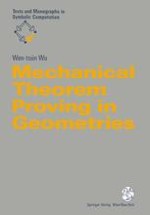1994 | OriginalPaper | Chapter
Orthogonal geometry, metric geometry and ordinary geometry
Author : Dr. Wen-tsün Wu
Published in: Mechanical Theorem Proving in Geometries
Publisher: Springer Vienna
Included in: Professional Book Archive
Activate our intelligent search to find suitable subject content or patents.
Select sections of text to find matching patents with Artificial Intelligence. powered by
Select sections of text to find additional relevant content using AI-assisted search. powered by
In Desarguesian (plane) geometry which takes Hilbert’s axioms of incidence H I, (sharper) axiom of parallels HIV, the axiom of infinity D∞ and Desargues’ axioms D as its basis, one can uniquely determine a Desarguesian number system N, called a geometry-associated Desarguesian number system, as has been exhibited in the previous sections. This number system is actually a skew field (of characteristic 0) and in general it does not satisfy the commutative axiom of multiplication N 13 of the complex number system. In order to let the commutative axiom of multiplication be satisfied, too, so that N becomes a number field, we must introduce other axioms in this geometry. One way, as shown in Hilbert’s “Grundlagen der Geometrie,” is to introduce the so-called Pascalian axiom. What Hilbert called the Pascalian axiom is actually a special case of the theorem commonly named after Pappus. It is also a special case of Pascal’s theorem in usual projective geometry where the conic section degenerates into two lines. To distinguish the axiom considered by Hilbert from the general Pappus’ and Pascal’s theorems, we call it the linear Pascalian axiom, stated as follows.
